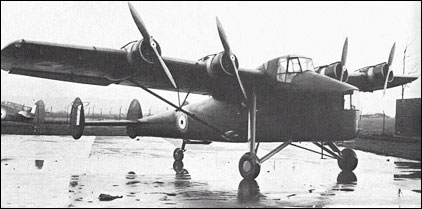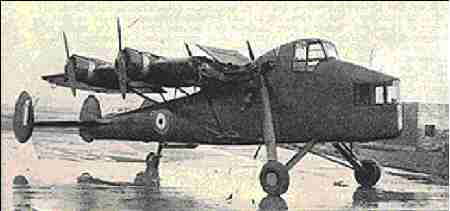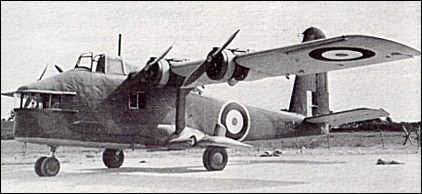Airspeed ModelThe Airspeed A.S.39 Fleet Shadower was a British long-range patrol aircraft design that did not go beyond the prototype stage. While the concept of a fleet shadower had some promise, the resulting prototypes were soon overtaken by wartime developments in airborne radar.
The Royal Navy envisaged a need (Operational Requirement OR.52) for an aircraft that could shadow enemy fleets at night and the resulting Specification S.23/37 called for a slow-flying low-noise aircraft with a long range, capable of operating from an aircraft carrier's flight deck. The specified performance was to be a speed of 38 knots at 1500 ft for not less than six hours.[1]
Five companies showed interest: Percival, Short Brothers, Fairey Aviation, General Aircraft Ltd and Airspeed.
General Aircraft submitted the G.A.L.38, of very similar general design to the A.S.39. General Aircraft and Airspeed were selected to build two prototypes each and Airspeed received awarded a contract on 10 August 1938.
The A.S.39 was a high-wing, semi-cantilever, strut-braced (on the outer panels) monoplane with wooden wings and tail unit and an all-metal monocoque fuselage. It had a fixed, divided type landing gear and tailwheel. The observation aircraft had a crew of three: pilot, observer and radio operator. The A.S.39 had a unique crew configuration with the observer accommodated in the nose with clear-vision windows on three sides and the pilot's compartment raised to allow passage to the radio operator's compartment. Four small 130hp Pobjoy Niagara V seven-cylinder radial air-cooled engines were mounted on the wings. Each wing and an engine could be folded for storage when used on an aircraft carrier.
Of two prototypes started, only one was completed, flying on 17 October 1940, the first flight was delayed due to problems with the Niagara V engines which had a vibration problem. The prototype had stability problems and poor stall handling not helped by the under-powered engines. Airspeed were asked to respond to a proposal to re-engine the aircraft with two Armstrong Whitworth Cheetah XI radial engines and add rear-facing machine guns. Only a preliminary proposal had been made and the second aircraft was not complete when on 17 February 1941 the Navy cancelled the fleet shadower program along with the AS.39, the company were requested to scrap both aircraft. The competing G.A.L.38 flew for a few months before it was cancelled and scrapped in March 1942. The requirement for such aircraft had been made obsolete due to the introduction of radar on long-range patrol aircraft such as the Liberator I.
General characteristicsCrew: 3 (Pilot, observer, radio operator)
Length: 39 ft 10 in (12.14 m)
Wingspan: 55 ft 4 in (16.87 m)
Height: 10 ft 5 in (3.18 m)
Wing area: 469 ft² (43.6 m²)
Empty weight: 4,592 lb (2087 kg)
Loaded weight: 6,935 lb (3,152 kg)
Powerplant: 4 × Pobjoy Niagara V seven-cylinder air-cooled radial engines, 140 hp (104 kW) each
PerformanceMaximum speed: 126 mph (110 knots, 203 km/h) at 5,000 ft (1,500 m)
Cruise speed: 113 mph (98 knots , 182 km/h) at 5,000 ft (1,500 m)
Stall speed: 33 mph (29 knots, 53 km/h) at sea level
Endurance: 6 hours
Service ceiling: 14,700 ft [5] (4,480 m)
Rate of climb: 865 ft/min (4.40 m/s)
Climb to 10,000 ft (3,050 m): 18 min
ArmamentNone



 General Aircraft Model
General Aircraft ModelThe General Aircraft G.A.L.38 Fleet Shadower was a British long-range patrol aircraft design of the immediate pre-Second World War period. Although the Fleet Shadower was a highly specialized aircraft that would have fitted a tactical need, its concept produced an ungainly and ultimately unsuccessful type.
The G.A.L.38 Fleet Shadower and the Airspeed A.S.39 Fleet Shadower were produced to meet Specification S.23/37, which came from the Royal Navy's "Operational Requirement OR.52" for an aircraft that could shadow enemy fleets at night. Three other companies were also involved initially: Percival, Short Brothers and Fairey Aviation. Following evaluation of the designs General Aircraft and Airspeed were contracted to build two prototypes each, General Aircraft contract dated 15 November 1938.
The specified performance of a successful design was a speed of 38 knots at 1,500 feet for not less than six hours. The design would also have to be able to operate from an aircraft carrier flight deck and hence use a folding wing configuration for easier deck storage. It would have to give good views for the observer and be quiet at cruising speed.
The G.A.L.38 and the A.S.39 designs were similar – both high-wing aircraft with fixed landing gear using four small Pobjoy Niagara V engines spread across the wings to generate lift at low speed. There was an observer's position in a glazed compartment in the nose and a radio operator's station in the fuselage behind the pilot's cockpit.
The aircraft was fitted with various devices to increase lift; slotted flaps and slotted ailerons and, on the low wing sponsons, split flaps. The wings folded back, pivoted close to the fuselage, on hydraulic power.
Due to development problems at Pobjoy with the Niagara V, it was decided to use the lower-powered Niagara III civil version. The first G.A.L.38 Fleet Shadower (also known as the "Night Shadower") flew on 13 May 1940 with the Niagara III engines. An innovative use of the "propwash" generated by propellers directed over the full-span flaps led to an impressive minimum speed of 39 mph (63 km/h) which would have allowed the Fleet Shadower to cruise effortlessly above an enemy fleet. During testing the aircraft suffered from aerodynamic stability problems, but not as bad as the Airspeed design which was cancelled in February 1941. The aircraft had major modification before flying again in June 1941 with the Niagara V engines; the three tail fins having been replaced by a single large fin. With the incomplete second G.A.L.38 being used as a spares source, test flying continued until September 1941. In October 1941 the company was instructed to scrap the second aircraft, and in March 1942 instructions were issued to scrap the prototype as well.
The concept of a fleet patrol aircraft was superseded by the wartime development of effective Air to Surface (ASV) radar that could be fitted in long-range patrol aircraft such as the Consolidated Liberator I. In February 1941, the Royal Navy cancelled the project.
General characteristicsCrew: Three (pilot, observer, radio operator)
Length: 36 ft 1 in (11 m)
Wingspan: 55 ft 10 in[4] (17.02 m)
Height: 12 ft 8 in (3.86 m)
Wing area: 472 ft² (43.85 m²)
Empty weight: 6,153 lb (2,791 kg)
Loaded weight: 8,591 lb (3,897 kg)
Useful load: 3,305 lb (1,500 kg)
Max. takeoff weight: 9,458 lb (4,290 kg)
Powerplant: 4 × Pobjoy Niagara III air-cooled geared radial engine, 130 hp (99 kW) each
PerformanceMaximum speed: 115 mph (185 km/h)
Cruise speed: 94 mph (152 km/h)
Stall speed: 39 mph (63 km/h)
Range: 990 m (1,593 km)
Service ceiling: 6,000 ft (1,830 m)
Rate of climb: 390 ft/min (119 m/min)
Wing loading: 20.0 lb/ft² (97.8 kg/m²)
Endurance: 11 hours
Lift coefficient: about 3.5
ArmamentNone



 Author
Topic: General Aircraft Fleet Shadower and Airspeed Fleet Shadower (Read 5350 times)
Author
Topic: General Aircraft Fleet Shadower and Airspeed Fleet Shadower (Read 5350 times)


